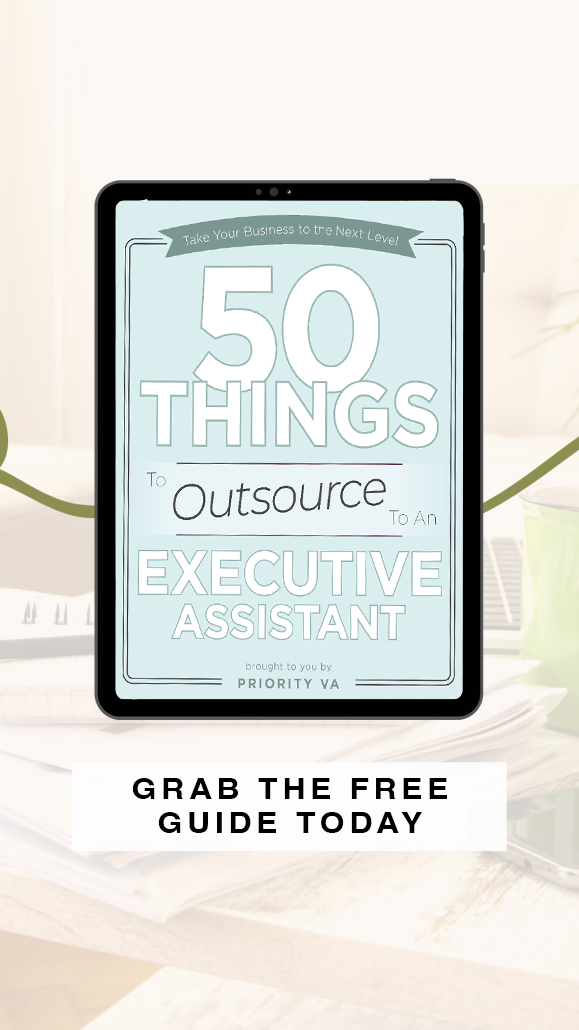Every day in your role as an Executive Assistant, a thousand nagging things compete for your attention.
Unfortunately, when everything feels like the priority, you accomplish very little. This is the reason so many at work are busy, but not productive.
The question then becomes: what really is the most important thing? How do you know where to spend your time? What do you tackle from your todo list first?
In this post, we are going to share different systems to help you identify what is urgent and what’s not.
We will also teach you how to pivot when new priorities rise to the top, because let’s be honest, we know your Leader is prone to throwing curveballs after you have priority-set. You have to be prepared for that!
Rocks and Water
In his book, “First Things First,” Stephen Covey introduces the idea of Rocks, or crystal-clear priorities. Rocks are foundational to EOS®, the Entrepreneurial Operating System.
This is how Covey explains rocks. Imagine a glass jar on the table. Next to the jar are rocks, gravel, sand and a glass of water. The jar is all of the time you have during the work day.
The rocks represent your main priorities. Gravel is your day-to-day responsibilities. Sand is interruptions and water is everything else that happens during the day.
If you pour the water in first, followed by the sand, gravel and then rocks…the rocks won’t fit.
That is a typical work day.
To make everything fit, Covey (and EOS) recommend adding these items to the jar in the reverse order.
Put the rocks in first, followed by gravel, then sand and THEN pour in the water.
You’ll see that everything fits inside the jar. The lesson is that if you work on your biggest priorities, or rocks, first, everything else will fall into place.
When you don’t know what to tackle first, ask yourself: Is this a rock, gravel, sand or water? This will help you tune-out the noise competing for your attention and stay focused to your top priorities.
How you decide your top priorities, or goals, is up to you based on the system you choose.
Systems to Set Priorities
There are so many systems for goal setting, or prioritization, it can be overwhelming. With anything, the key is to be consistent.
No system must serve you forever. And choosing one system doesn’t mean (necessarily) you have to forfeit all others. Don’t put that pressure on yourself.
For years, our team used Todd Herman’s 90 Day Year performance system. 90 Day Year uses two-week sprints to hyper focus your team’s productivity. That served us for a time. Now, we are striving to become EOS purists.
Here are various systems for you to consider to become accountable to your goals.
1. Entrepreneurial Operating System® (EOS)
EOS helps everyone work toward the same goals. It aligns your vision, so your direction is laser-focused. EOS is made up of six basic components, which are vision, data, process, traction, issues and people.
It makes sure the right people are in the right seat and gives you user-friendly tools like a Vision/Traction Organizer, Scorecard and The Issues List to keep everyone accountable.
2. OKRs
Objectives and Key Results, or OKRs, is a goal-setting methodology that helps teams set measurable goals. It originated with Andy Grove at Intel, who believed that teams performed better when they focused on an outcome, rather than a procedure.
You can think of OKRs in this template, “I will [objective] as measured by [key result].”
The objective is your goal and the key result is the metric you’ll use to measure your progress. For example, if your metric is to increase brand awareness, your key result would be to increase website traffic by 10%.
3. S.M.A.R.T. goals
S.M.A.R.T. goals are specific, measurable, achievable, relevant and time bound. Too often, the goals we set for ourselves are vague, unrealistic, unmeasurable and irrelevant to our current efforts or resources.
The S.M.A.R.T. system helps you set clear and reachable goals by asking you to define these parameters. For example, for something to be Achievable, you need to ask yourself, “How realistic is this goal based on our financial constraints?” For something to be Relevant, you must ask, “Is this the right time?”
Grounding Your Executive
Once you’ve decided on a priority setting system, you need to agree upon your goals with your Leader and make sure they are communicated with the team.
In following EOS, we strive to set clear goals for the individual and the organization every quarter. These are your rocks that fill “the jar” first.
Even if you aren’t using “rocks” per se, the same principle applies. Your OKRs or your S.M.A.R.T. goals should be prioritized FIRST before the distractions of the day pile up.
If you are managing your Executive’s calendar — and you should be — you can modify their week to align with your organization’s rocks. Put reserved blocks for the MOST important thing they should be doing. Hold them accountable — don’t let them move those events!
Pro tip: schedule this work at the time her or she feels the most energized or productive.
If your Leader’s rock for the quarter is to finish a book manuscript, put writing blocks on the calendar when he or she feels their best.
Apply this same advice to yourself. What is your top priority for this quarter? When gravel, sand and water compete for your attention, are you making time to handle the rocks first? Adjust your calendar accordingly.
Driving Clarity
It is your responsibility as the assistant to ground your Leader when you see them spiraling away from their goals.
Asking clarifying questions such as, “You said you wanted us to rebrand the website, and that was the top priority for this quarter. Is that still the No. 1 thing, or is the book launch now the number one thing?”
Leaders are prone to throwing entrepreneurial hand grenades. What was important to them three days ago might not be important now.
You have to keep your Executive grounded and on track by REMINDING them of the things they said they were going to do, or wanted to do.
Plan for Curveballs
Goals are not supposed to change in a 90-day period (or whatever timeline you decide on). The reason is simple. If the target keeps moving, how are you supposed to hit it?
This is why the “R” in S.M.A.R.T. is so important to define. You need to set goals that are the most relevant to your company, so you aren’t constantly derailed by competing priorities.
Unfortunately, real life happens. Outside influences can throw off even the best laid plans.
If you pigeon-hole your Leader to stay inside the “box” of quarterly goals in the face of crisis, economic downturn, employee turnover, a new competitor, burnout or family issues — whatever the problem may be — you may be hindering your Exec’s ability to solve the problem.
Create Space to Solve the Problem
When your Leader is faced with competing priorities, try to create more space for them in their calendar. Go back to the basics of delegation. Is there anything on your Leader’s plate that doesn’t need to be there?
What can be outsourced? And what can only be done by them? Review what is on their todo list and see what you can take off of it.
This will create more time in their calendar to tackle their rocks.
By helping your Leader prioritize, you are taking the lead as an Executive Assistant. This shows you’re not “just” administrative support. You are a strategic and trusted partner who drives outcomes and results!
Save Your Seat
Our FREE masterclass, “How to Own Your Power and Take the Lead as an Executive Assistant,” was created for assistants like you who are ready to step-up their game.
This three-part video masterclass series will teach you:
1. Strategies for setting boundaries you’re proud of with a new or existing client. Wouldn’t you like to finally put your phone down, while still being seen as a rockstar in the eyes of the Leader you serve? We’ll show you how, so you can unplug with confidence and without anxiety.
2. Communication tactics for being heard, adding value and driving clarity. If you struggle with hard conversations, or don’t know how to approach your Executive, we’ve got advice to help you take the lead.
3. How to revamp a stale relationship with your Leader, or ensure success with a new partnership. You’ll discover timeless and practical onboarding strategies you can implement right away to realign a tired partnership.
Ready to learn real-world strategies you can implement right away? Sign up here before registration closes.





